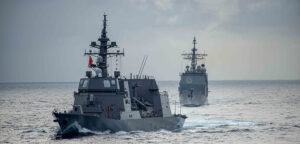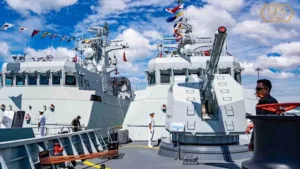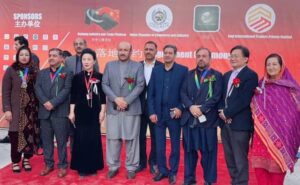China’s Foray into Far East Seaports
China’s is expanding its global maritime footprint and this may be a cause of concern for the US. China is flooding huge private and public cash into Cambodia especially targeting the capital city of Phnom Penh and port cities like Sihanoukville.Currently major upgrades to the nearby Ream Naval Base are underway bolstered by significant support from China.It is Japan’s security vulnerabilities that drive its security diplomacy and foreign policy in Cambodia . Two Japanese Maritime Self-Defense Force destroyers, the Suzunami and Shimakaze, each with a crew complement of about 200 sailors recently made a stop at the Sihanoukville port perhaps to display Japanese naval strength.

Credit ; Geo political Monitor by Mark S. Cogan

Credit ; CNN -Two Chinese People’s Liberation Army Navy corvettes dock at the Ream Naval Base in Cambodia.
China Entry into IMF Debt Stricken African Islands
Eight years ago the African island nation of São Tomé and Príncipe initialled an agreement with China to construct the country’s first deepwater port. During the heyday,ranging from the years 2014 to 2017, of the Belt and Road Initiative (BRI) the envisaged port was celebrated for the connectivity it would grant to isolated São Tomé, allowing closer integration into the three regional economic regimes of Central, West and Southern Africa besides arranging sufficient revenues necessary to finance other initiatives related to health and education despite the project’s $800 million cost. In the year 2018 the deepwater port project was found to be unfeasible in the light of the country’s huge debt and limited financial capacity. Despite China’s offer to slash the cost of the project to around $600 million and apprehensive of Chinese fishing fleet’s track record of illegal, unregulated and irresponsible fishing practices the São Toméan government remained hesitant to allow Chinese companies access to its fishing stocks as São Tomé is dependent on fishing for its food security. Fresh bids were called from international construction companies. However due to a combination of São Tomé’s high levels of debt, subsequent credit restrictions under a deal with the International Monetary Fund (IMF) and its choice to use the public-private partnership (PPP) model, more demanding for the private sector partner as it must shoulder the financial burden of the project , construction options were constricted.
As São Tomé and China were unable to agree on the deep water port project’s financing and terms of final use São Tomé granted the deepwater port construction deal and a thirty-year lease on its operation to a Ghanaian Consortium . The cancellation of the Chinese port project in São Tomé is fairly unique as of the 101 Chinese overseas port projects only 9 have been cancelled.
Backlash to Chinese Investment
While most Chinese sponsored port projects move ahead 28 have faced domestic or international backlash usually relating to the environmental damage, “debt-traps” and future Chinese militarization concerns at the ports. Environmental and security concerns are present in all regions where China has financed ports with debt-trap concerns concentrated in Africa and South Asia. Many low-income countries that have limited access to credit welcome these projects as a much-needed infusion of capital and infrastructure investment. China has emerged as the largest bilateral lender to emerging economies.
Pakistan China All Weather Maritime Friendship
The consistency and scope with which China has been willing to lend is appreciated by the public in Pakistan where the Chinese debt trap diplomacy narrative originated. The Pakistani public values Chinese investment into its seaports even though China has been accused of playing a major role in the country’s current debt crisis. A 2022 public opinion survey of Pakistanis conducted at Czechia’s Palacký University Olomouc found that 85 % of survey respondents held a favorable view of China, while a 2022 Gallup Public Opinion poll found that 56 % of Pakistanis prefer to have a relationship with China when given the choice between China, the United States, Russia or the European Union. China’s long-term willingness to invest in Pakistan is perceived to be fuelling these sentiments.
Chinese Funding vs Paris Club
Whether Chinese port investments are met with excitement or suspicion it remains the most attractive or only option with a distinction that on account of its policy of non-interference Chinese funding is not accompanied by official political strings vis-a vis funding arranged from international financial institutions (IFIs), multilateral development banks (MDBs) and the so-called Paris Club group of wealthy countries. The lure of “free” money makes China an even more attractive partner for those countries where the feeling is rampant that they have been ditched by traditional partners. Such sentiments are reflected in the Greek government’s embrace of Chinese investment in the country’s Piraeus port after being forced to sell key pieces of infrastructure as part of its IMF debt relief deal.
Strategic Seaports Straddling Straits
Even countries that are interested in partnering with foreign governments other than China resort to borrowing from Chinese Banks and consortiums after their other offers are turned down. In the case of Hambantota port, a much talked about Chinese port project investment, the Sri Lankan government approached both the United States and India for investment and was turned down before approaching China. Prior to the announcement of the India-Middle East-Europe Corridor (IMEC) during the 2023 G20 summit there was only one case in which an external government cautioned a country not to accept a Chinese port project offer.
Price Cutting Tactics
Multilateral development banks and democracies remain desirous to continue to increase the scope of their infrastructure project portfolios in low and middle-income countries. These institutions are the benchmark for environmental, social and governance project standards and their presence in the competition for project tenders should persuade other bidders to match their own project standards. A decade ago Chinese companies may have won tenders in developing countries by undercutting on price alone playing on the price-sensitive nature of these markets. Recently China’s focus on low investment and high yield projects coupled with host country concerns about the quality and sustainability of Chinese contractors’ work has witnessed a paradigm shift towards maintaining quality.
West Offering Targeted logistic Corridors
The United States and other high income countries can arguably take several steps to offer an alternative to Chinese infrastructure investment. Although wealthy countries have proposed larger projects such as IMEC, more targeted projects such as the revival of the Lobito Corridor would be more practical and will reduce the risk of creating burdensome “white elephant” projects. Meanwhile, development finance organisations should continue to seek opportunities to collaborate with one another as well as with the private sector to fund infrastructure projects in low and middle-income countries. Progress has been made in this respect such as the Memorandum of Understanding between the U.S. Development Finance Corporation (DFC), the Japan Bank for International Cooperation (JBIC) and South Korea’s Export-Import Bank (KEXIM) to strengthen cooperation on infrastructure financing. The DFC’s strength lies in its ability to mobilize private sector investment being generally prohibited from partnering with state-owned enterprises (SOEs) whereas JBIC and KEXI frequently partner with government ministries and SOEs. Collaboration between these three organisations expands development finance coverage across the board.
Host country governments like Pakistan can maximize benefits of maritime infrastructure projects by stipulating local sourcing for a certain proportion of the project’s workforce or materials used in construction and even where non Chinese financing is costlier there will be increased local participation , employment and technology transfers.
China’s External Energy Paranoia
The Port of Hambantota commenced operations albeit on a small scale in the year 2010 prior to China’s Belt and Road Initiative. China remains acutely reliant on imported energy manifested in its “ Malacca Dilemma “ and the Port of Hambantota conveniently landed in the lap of Belt and Road Initiative . The government of Sri Lanka first significant loan was obtained from China’ Export Import Bank (Exim) for a sum of USD 307 million. Accompanying this loan was a condition that China Harbor would construct the port. It is not unusual for China to insist that its basically state backed corporates have exclusive rights for its projects instead of participating in an open bidding process as evidenced in the Chinese government lending dollars to be repaid at a premium to hire Chinese companies. At the same time the employment consists mostly of Chinese . Contrary to public opinion the debt servicing cost on account of the loans obtained from Exim bank were not significant in the overall context of external loan portfolio of Sri Lanka with loan instalments (including interest) not even to the extent of 5 % of Sri Lanka’s total external debt repayments.

Credit; Hunza , Nagar and Gilgit Chambers Agreement Signing Ceremony with Chinese business entities
China Changes Strategy in Pakistan through B2B
China’s own economic slowdown is now prompting policymakers to turn their attention inwards and focus on domestic economic imperatives. But as China pivots away from large infrastructure projects due to a reassessment of its goals and priorities for the BRI low and middle-income countries’ thirst for access to capital and credit will not abate. The West should demonstrate leadership through sustained investment with its partners particularly small and medium size states such as São Tomé that may be forced to accept sub-optimal or detrimental agreements due to lack of options. Chinese companies while competing for such projects or tenders should raise their environmental , social benchmarks and transparency standards to conform to international financiers and host countries requirements. The goal for Paris Club members, IFIs and MDBs should ultimately be to increase project sustainability and transparency across the board aimed at improving project outcomes despite any bidder winning the contract.
Authors ; Nadir Mumtaz & Razeen Ahmed
Credit/Source ;
Nadia Clark – Research Associate for International Political Economy at the Council on Foreign Relations.
https://www.nytimes.com/interactive/2022/09/26/world/asia/china-fishing-south-america.html
https://www.cfr.org/tracker/china-overseas-ports
https://gallup.com.pk/post/34254
https://www.cfr.org/councilofcouncils/global-memos/was-g20-summit-turning-point-global-south
https://www.globaltrademag.com/greek-to-sell-two-ports-as-part-of-bailout/
https://www.bbc.com/news/world-asia-china-67120726
https://www.nytimes.com/2017/08/26/world/europe/greece-china-piraeus-alexis-tsipras.html

Leave A Comment